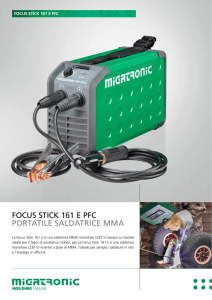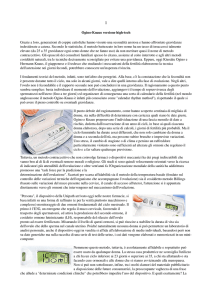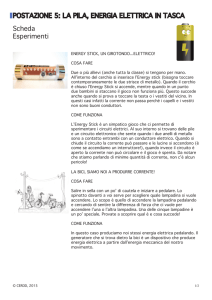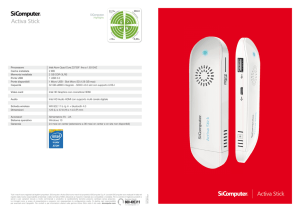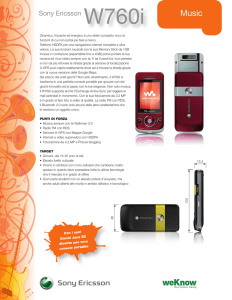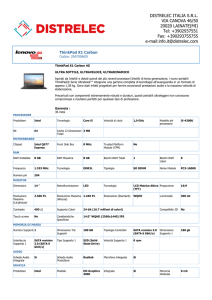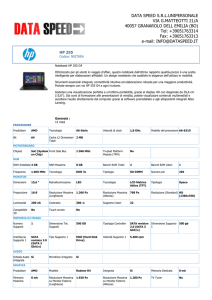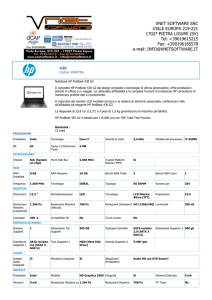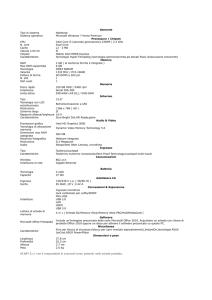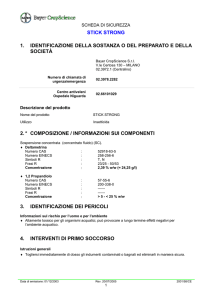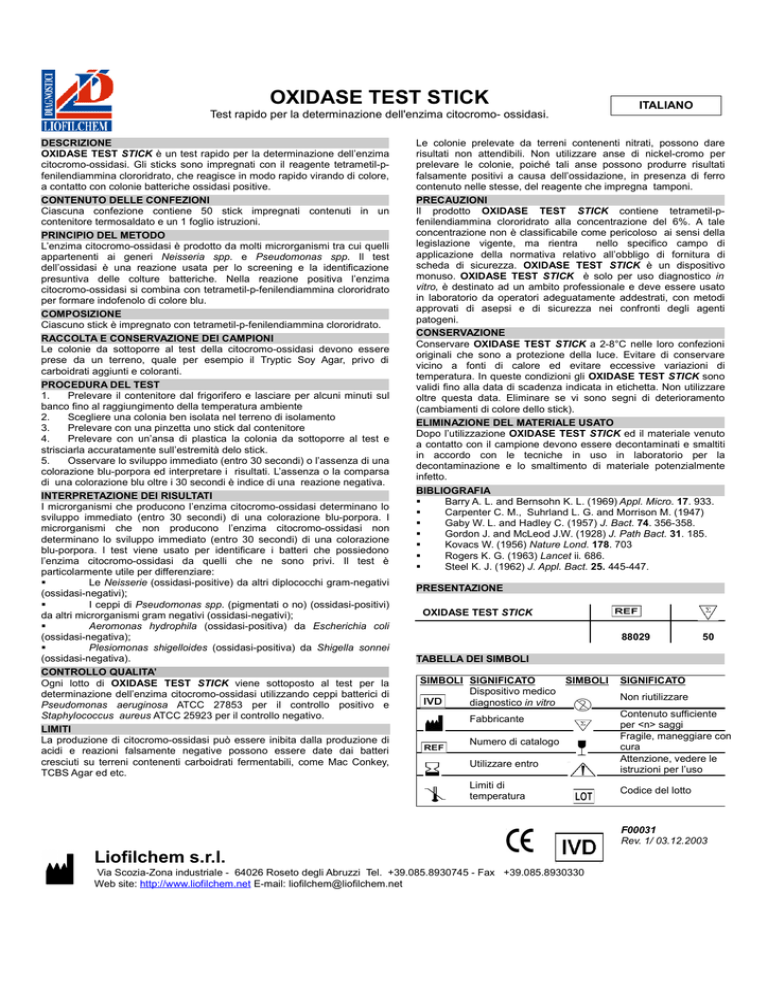
OXIDASE TEST STICK
Test rapido per la determinazione dell'enzima citocromo- ossidasi.
DESCRIZIONE
OXIDASE TEST STICK è un test rapido per la determinazione dell’enzima
citocromo-ossidasi. Gli sticks sono impregnati con il reagente tetrametil-pfenilendiammina clororidrato, che reagisce in modo rapido virando di colore,
a contatto con colonie batteriche ossidasi positive.
CONTENUTO DELLE CONFEZIONI
Ciascuna confezione contiene 50 stick impregnati contenuti in un
contenitore termosaldato e un 1 foglio istruzioni.
PRINCIPIO DEL METODO
L’enzima citocromo-ossidasi è prodotto da molti microrganismi tra cui quelli
appartenenti ai generi Neisseria spp. e Pseudomonas spp. Il test
dell’ossidasi è una reazione usata per lo screening e la identificazione
presuntiva delle colture batteriche. Nella reazione positiva l’enzima
citocromo-ossidasi si combina con tetrametil-p-fenilendiammina clororidrato
per formare indofenolo di colore blu.
COMPOSIZIONE
Ciascuno stick è impregnato con tetrametil-p-fenilendiammina clororidrato.
RACCOLTA E CONSERVAZIONE DEI CAMPIONI
Le colonie da sottoporre al test della citocromo-ossidasi devono essere
prese da un terreno, quale per esempio il Tryptic Soy Agar, privo di
carboidrati aggiunti e coloranti.
PROCEDURA DEL TEST
1.
Prelevare il contenitore dal frigorifero e lasciare per alcuni minuti sul
banco fino al raggiungimento della temperatura ambiente
2.
Scegliere una colonia ben isolata nel terreno di isolamento
3.
Prelevare con una pinzetta uno stick dal contenitore
4.
Prelevare con un’ansa di plastica la colonia da sottoporre al test e
strisciarla accuratamente sull’estremità delo stick.
5.
Osservare lo sviluppo immediato (entro 30 secondi) o l’assenza di una
colorazione blu-porpora ed interpretare i risultati. L’assenza o la comparsa
di una colorazione blu oltre i 30 secondi è indice di una reazione negativa.
INTERPRETAZIONE DEI RISULTATI
I microrganismi che producono l’enzima citocromo-ossidasi determinano lo
sviluppo immediato (entro 30 secondi) di una colorazione blu-porpora. I
microrganismi che non producono l’enzima citocromo-ossidasi non
determinano lo sviluppo immediato (entro 30 secondi) di una colorazione
blu-porpora. l test viene usato per identificare i batteri che possiedono
l’enzima citocromo-ossidasi da quelli che ne sono privi. Il test è
particolarmente utile per differenziare:
Le Neisserie (ossidasi-positive) da altri diplococchi gram-negativi
(ossidasi-negativi);
I ceppi di Pseudomonas spp. (pigmentati o no) (ossidasi-positivi)
da altri microrganismi gram negativi (ossidasi-negativi);
Aeromonas hydrophila (ossidasi-positiva) da Escherichia coli
(ossidasi-negativa);
Plesiomonas shigelloides (ossidasi-positiva) da Shigella sonnei
(ossidasi-negativa).
CONTROLLO QUALITA’
Ogni lotto di OXIDASE TEST STICK viene sottoposto al test per la
determinazione dell’enzima citocromo-ossidasi utilizzando ceppi batterici di
Pseudomonas aeruginosa ATCC 27853 per il controllo positivo e
Staphylococcus aureus ATCC 25923 per il controllo negativo.
LIMITI
La produzione di citocromo-ossidasi può essere inibita dalla produzione di
acidi e reazioni falsamente negative possono essere date dai batteri
cresciuti su terreni contenenti carboidrati fermentabili, come Mac Conkey,
TCBS Agar ed etc.
ITALIANO
Le colonie prelevate da terreni contenenti nitrati, possono dare
risultati non attendibili. Non utilizzare anse di nickel-cromo per
prelevare le colonie, poiché tali anse possono produrre risultati
falsamente positivi a causa dell’ossidazione, in presenza di ferro
contenuto nelle stesse, del reagente che impregna tamponi.
PRECAUZIONI
Il prodotto OXIDASE TEST STICK contiene tetrametil-pfenilendiammina clororidrato alla concentrazione del 6%. A tale
concentrazione non è classificabile come pericoloso ai sensi della
legislazione vigente, ma rientra
nello specifico campo di
applicazione della normativa relativo all’obbligo di fornitura di
scheda di sicurezza. OXIDASE TEST STICK è un dispositivo
monuso. OXIDASE TEST STICK è solo per uso diagnostico in
vitro, è destinato ad un ambito professionale e deve essere usato
in laboratorio da operatori adeguatamente addestrati, con metodi
approvati di asepsi e di sicurezza nei confronti degli agenti
patogeni.
CONSERVAZIONE
Conservare OXIDASE TEST STICK a 2-8°C nelle loro confezioni
originali che sono a protezione della luce. Evitare di conservare
vicino a fonti di calore ed evitare eccessive variazioni di
temperatura. In queste condizioni gli OXIDASE TEST STICK sono
validi fino alla data di scadenza indicata in etichetta. Non utilizzare
oltre questa data. Eliminare se vi sono segni di deterioramento
(cambiamenti di colore dello stick).
ELIMINAZIONE DEL MATERIALE USATO
Dopo l’utilizzazione OXIDASE TEST STICK ed il materiale venuto
a contatto con il campione devono essere decontaminati e smaltiti
in accordo con le tecniche in uso in laboratorio per la
decontaminazione e lo smaltimento di materiale potenzialmente
infetto.
BIBLIOGRAFIA
Barry A. L. and Bernsohn K. L. (1969) Appl. Micro. 17. 933.
Carpenter C. M., Suhrland L. G. and Morrison M. (1947)
Gaby W. L. and Hadley C. (1957) J. Bact. 74. 356-358.
Gordon J. and McLeod J.W. (1928) J. Path Bact. 31. 185.
Kovacs W. (1956) Nature Lond. 178. 703
Rogers K. G. (1963) Lancet ii. 686.
Steel K. J. (1962) J. Appl. Bact. 25. 445-447.
PRESENTAZIONE
OXIDASE TEST STICK
88029
50
TABELLA DEI SIMBOLI
SIMBOLI SIGNIFICATO
SIMBOLI
Dispositivo medico
diagnostico in vitro
Fabbricante
Numero di catalogo
Utilizzare entro
Limiti di
temperatura
SIGNIFICATO
Non riutilizzare
Contenuto sufficiente
per <n> saggi
Fragile, maneggiare con
cura
Attenzione, vedere le
istruzioni per l’uso
Codice del lotto
F00031
Rev. 1/ 03.12.2003
Liofilchem s.r.l.
Via Scozia-Zona industriale - 64026 Roseto degli Abruzzi Tel. +39.085.8930745 - Fax +39.085.8930330
Web site: http://www.liofilchem.net E-mail: [email protected]
OXIDASE TEST STICK
Rapid test for determining the oxydase-cytochrome enzyme.
DESCRIPTION
OXIDASE TEST STICK is a rapid test for determining the oxydasecytochrome enzyme. The sticks are impregnated with the tetramethyl-pphenylenadiamine hydrochloride reagent, which reacts rapidly by
changing colour when it comes into contact with the positive oxydase
bacteria colonies.
CONTENTS OF THE PACKAGES
Each package contains 50 impregnated sticks contained in a heatsealed packets and an instruction sheet.
METHOD PRINCIPLE
The oxydase-cytochrome enzyme is produced from many
microorganisms belonging to the Neisseria spp. and Pseudomonas spp.
geni. The oxydase test is a reaction that is used for presumptive
screening and the presumptive identification of bacterial cultures. In the
positive reaction, the oxydase-cytochrome enzyme combines with
tetramethyl-p-phenylenadiamine hydrochloride to form indophenol blue.
COMPOSITION
Each stick is impregnated with hydrochloride tetramethyl-pphenylenadiamine.
GATHERING AND KEEPING SAMPLES
The colonies to be subjected to the oxydase-cytochrome test must be
taken from a medium such as Tryptic Soy Agar without added
carbohydrates or colouring.
TEST PROCEDURE
1.
Take the container from the refrigerator and leave it for a few
minutes on the bench until it has reached ambient temperature
2.
Choose a colony that is well isolated in the isolation medium
3.
Use tweezers to take a stick from the container.
4.
With a loop of plastic, take the colony to be subjected to the test
and smear it meticulously on the end of the stick.
5.
Observe the immediate development (within 30 seconds) or the
absence of a purple-blue colour and interpret the results. The absence or
appearance of a blue colouring after 30 seconds indicates a negative
reaction.
EVALUATING THE RESULTS
The microorganisms that produce the oxydase-cytochrome enzyme
determine the immediate (within 30 seconds) development of a purpleblue colour. The microorganisms that do not produce the oxydasecytochrome enzyme do not determine the immediate (within 30 seconds)
development of a purple-blue colour. The test is used to distinguish the
bacteria that possess the oxydase-cytochrome enzyme from those that
do not. The test is particularly useful for distinguishing:
Neisserie (positive oxydase) from other gram-negative diplococci
(negative oxydases);
The strains of Pseudomonas spp. (pigmented or not) (positive
oxydase) from other gram-negative microorganisms (negative oxydase);
Aeromonas hydrophila (positive oxydase) from Escherichia coli
(negative oxydase);
Plesiomonas shigelloides (positive oxydase) from Shigella sonnei
(negative oxydase).
QUALITY CONTROL
Each batch of OXIDASE TEST STICK is subjected to the test for
determining the oxydase-cytochrome enzyme using bacterial strains of
Pseudomonas aeruginosa ATCC 27853 for the positive test and
Staphylococcus aureus ATCC 25923 for the negative test.
LIMITS
The production of oxydase-cytochrome may be inhibited by the
production of acids and falsely negative reactions may be given by
bacteria grown on media containing fermentable carbohydrates such as
Mac Conkey, TCBS Agar etc.
ENGLISH
The colonies taken from media containing nitrates may give unreliable
results. Do not use nickel-chrome loops to take colony samples, as
such loops may produce falsely positive results due to oxidation
because of the iron contained in the loops and of the reagent that
impregnates the sticks.
PRECAUTIONS
The OXIDASE TEST STICK contain tetramethyl-p-phenylenadiamine
hydrochloride in a 6% concentration. This concentration is not
classified as hazardous by current legislation but a safety datasheet
must be drawn up for this specific application. OXIDASE TEST STICK
is disposable. OXIDASE TEST STICK must be used only for
diagnostic in vitro use. This is designed for professional use and must
be used in a laboratory by suitably trained operators using approved
aseptic and safety methods for dealing with pathogenic agents.
STORAGE
Keep OXIDASE TEST STICK at 2-8°C in their original packaging
protected from sunlight. Keep them away from sources of heat and
avoid excessive temperature fluctuations. In these conditions,
OXIDASE TEST STICK are valid until the expiry date shown on the
label. Do not use them beyond that date. Dispose of them if they show
signs of deterioration (sticks changes colour).
ELIMINATING USED MATERIAL
After use, OXIDASE TEST STICK and the material that has come into
contact with the sample must be decontaminated and disposed of in
accordance with the laboratory procedures for the decontamination
and disposal of potentially infected material.
BIBLIOGRAPHY
Barry A. L. and Bernsohn K. L. (1969) Appl. Micro. 17. 933-934.
Carpenter C. M., Suhrland L. G. and Morrison M. (1947)
Science 105. 649-650.
Gaby W. L. and Hadley C. (1957) J. Bact. 74. 356-358.
Gordon J. and McLeod J.W. (1928) J. Path Bact. 31. 185.
Kovacs W. (1956) Nature Lond. 178. 703
Rogers K. G. (1963) Lancet ii. 686.
Steel K. J. (1962) J. Appl. Bact. 25. 445-447.
PRESENTATION
OXIDASE TEST STICK
TABLE OF SYMBOLS
SYMBOL MEANING
88029
SYMBOL
50
MEANING
In Vitro Diagnostic
Medical Device
Do not reuse
Manufacturer
Contains sufficient for
<n> tests
Catalogue number
Fragile, handle with care
Use by
Caution, consult
accompanying
documents
Temperature
limitation
Batch code
F00031
Rev. 1/ 03.12.2003
Liofilchem s.r.l.
Via Scozia-Zona industriale - 64026 Roseto degli Abruzzi Tel. +39.085.8930745 - Fax +39.085.8930330
Web site: http://www.liofilchem.net E-mail: [email protected]

